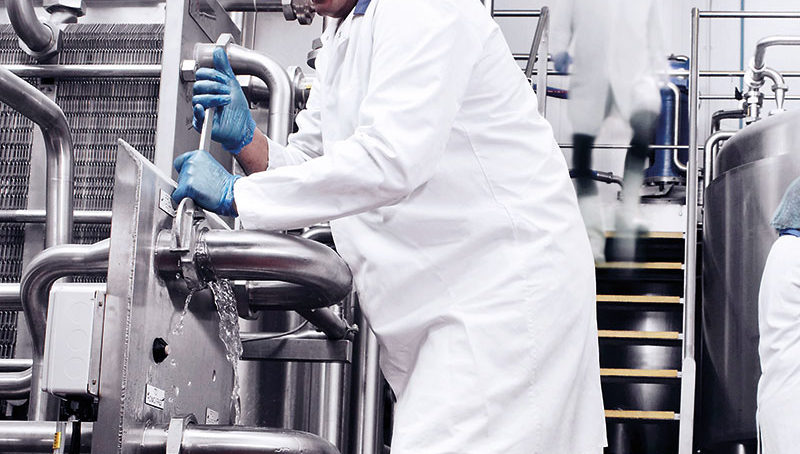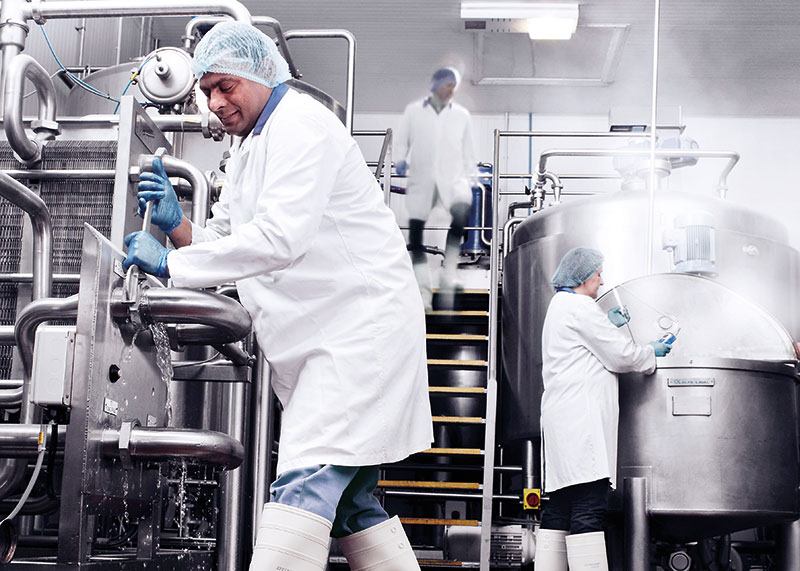
With below-par cleanliness and poor hygiene risking significant repercussions for an establishment, ongoing training, supervision, inspection systems and new innovations all have an essential part to play in today’s regimes

It’s every hospitality industry player’s worst nightmare and can come like a bolt out of the blue, leaving a tsunami-like trail of destruction in its wake. An outbreak of food poisoning at a restaurant or flu-like symptoms from a poorly maintained air-conditioning system can produce repercussions that are highly damaging, long-lasting and costly.
Fortunately, few hotels and restaurants will find themselves facing such dramatic scenarios, but they certainly serve as a stark warning to the possible consequences of neglecting cleaning and hygiene tasks.
The need for clean
According to Keith Warren, director of the UK-based Catering Equipment Suppliers Association (CESA), customers are likely to notice signs of anything untoward when it comes to cleanliness, even minor details, and will store their concerns away for future reference.
“Few things put people off more than dirt and clutter. Everything – surfaces, crockery, floor, staff fingernails, and so on – it all needs to be spotless,” he told HN. “Get it wrong and people will walk away. Not only will they not come back, they’ll also warn their friends.”
In today’s climate of informed and demanding visitors, who will be all too aware that such observations could perhaps be a sign of bigger or underlying problems, customers warning others off is just one repercussion of poor hygiene, according to Paul Casson, technical field manager at Rentokil Specialist Hygiene, part of industry specialist, Rentokil Initial.
“A failure to maintain basic hygiene standards could cost businesses more than just a happy customer – it can lead to bad reviews, a damaged reputation and even a visit from a safety inspector,” he said. “To prevent situations that could compromise the health and safety of customers and staff, hospitality businesses need to enforce a regular and proactive cleaning regime.”
While problems can arise in any establishment that fails to implement such a regime, properties in sunny climes, such as MENA destinations, are especially susceptible to the perils of inadequate cleaning programs. High volumes of food and footfall, alongside al fresco dining, can combine to create a perfect storm of potential problems.
According to Casson, hot weather heightens the need to keep food items at the appropriate temperature to prevent the spread or growth of bacteria. “The bacteria which cause E.coli and Salmonella, for example, thrive on temperatures between 4 and 60 degrees, more widely known as the ‘food danger zone’,” he said. “To minimise this danger, perishable food shouldn’t be allowed to spend more than an hour at this temperature, or they should be thrown away/cooked.”
Cross contamination, undercooked food and uncovered food left exposed to the environment are among the most common sources of food hygiene complaints made by clients of the UK-based law firm Irwin Mitchell, according to associate, Clare Comiskey.
“The cases that we deal with range from bacterial illness contracted from food, such as Salmonella, to viral illness where there has been a failure to warn or a lack in the prevention of spread of the infection,” she told HN. “In addition, cruise ship holidays involving repeated outbreaks of norovirus ruining guests’ holidays.”
T is for training
So why, in an era when the far-reaching impact of fall-out from these incidents is so well documented and there are more innovative cleaning products and techniques available than ever before are these outbreaks still occurring?
Comiskey believes the answer is often two-fold. “More often than not, poor hygiene is caused by a lack of care by the individual and this can be as a result of a training issue, where the food handler does not have sufficient training in dealing with food hygiene, and general cleanliness,” she told HN.
Few would argue that training in this critical field should be given a priority, whether it’s in the basics, specialist areas or reinforcing the establishment’s rules and requirements.
“Training should be ongoing – both for new staff and as a refresher for the whole kitchen brigade. All staff should be fully aware of the kitchen’s cleaning, hygiene and food safety procedures,” Warren said. “By developing cleaning training and regimes that are specifically designed to address food safety and general hygiene consistently, caterers can significantly decrease the risks of food-contaminated illnesses, protecting their customers and staff and avoiding the bad press and financial loss that come with it.”
Providing staff with the right tools, trainings and resources to enable them to perform their tasks effectively is a top priority for the Rotana Group, which is committed to implementing the highest levels of hygiene and cleanliness across all departments of the hotels’ operation, according to Christiane Abou Zeidan, corporate director of environment, Health and Safety, Rotana. “In addition, we continue to train colleagues on the importance of upkeeping the hygiene levels of our properties and further enhancing the quality of our services through a well-planned quality control inspection system,” she added. “Furthermore, we place particular emphasis on the implementation of the Hazard Analysis and Critical Control Points (HACCP) system and departmental standard operating procedures (SOPs), which include cleaning tasks checklists, back of house inspections, audits, surface and hand swab tests, and manuals for safe handling of chemicals, among several others, to ensure and validate that operational needs are being met systematically.”
Monitoring mechanisms
Regimens that include such tests, inspections and audits are a must in an industry characterized by high traffic and the potential for problems on a mass scale. “It’s worth knowing your high-risk areas and implementing a routine or researching innovations which can help you tackle these issues quickly, safely and efficiently,” Casson advised. As well as a regular, documented cleaning schedule, he also recommends a thorough deep clean during quieter trading times, such as after Christmas or before the summer rush begins.
R&D has helped to bring several new innovations to the market that are helping the industry address hygiene issues, with Smart creations among the most notable, especially when it comes to kitchens.
“The connected kitchen, whereby appliances are connected to the internet and can be monitored and even adjusted remotely, for example via an app on a smartphone, will have major implications for hygiene and food safety,” Warren told HN. “It will warn operators of issues such as low temperature water in a dishwasher, or problems with an oven, of fluctuating temperatures in a refrigerator. By ensuring equipment is operating correctly, connected technology will enhance safety for both staff and customers.”
Notable solutions
Among the innovations, Adenosine Triphosphate (ATP) testing is generating significant interest with industry players. When used in a monitoring system, this enzyme, which is present in all living cells, can detect the amount of organic matter that remains after cleaning an environmental surface, making it ideal for identifying problems, such as dangerous microbiological pathogens, on surfaces that might look clean to the naked eye.
Abou Zeidan told HN that in line with Rotana’s commitment to delivering the best guest experiences in a clean and healthy environment, the brand is currently exploring this significant innovation. “In order to ensure the effectiveness of these products and techniques in improving catering hygiene and housekeeping and environmental cleanliness, we are in the process of considering the adoption of the ATP hygiene monitoring device, which provides real-time feedback and verifies that cleaning procedures are working well in food and beverage as well as housekeeping areas,” she explained. “This new tool is more effective in comparison with traditional methods, such as visual inspection, microbiological testing and fluorescent marker audits.”
Another innovation recommended by Casson is Ultra Low Volume (ULV) Disinfectant Fogging, which involves generating a mist of 5-50-micron droplets of disinfectant. “Carried out by a trained cleaning specialist, ULV fogging significantly reduces the number of potentially harmful pathogens, as it can cover large spaces quickly and ensure those hard-to-reach areas that manual cleaning might miss are treated,” Casson said.
While kitchens are inevitably a focal point of cleaning, washrooms can be where several of the problems begin, as Jamie Woodhall, UK technical and innovation manager, Initial Washroom Hygiene at Rentokil Initial, explained.
“Used by many staff members and customers each day, it can be difficult to keep washrooms spotless,” he said. “A strict cleaning regime in washrooms is vital, given that most harmful bacteria originates here and 80 percent of common infections are transmissible by touch.”
Reminding staff about best practice handwashing and the possible consequences of spreading germs via shared touchpoints is key in this respect and something that should always be revisited, including encouraging employees to be responsible for their own hand hygiene.

Catering Equipment Suppliers Association
Keith Warren
Director

Rentokil Specialist Hygiene
Paul Casson
Technical Field Manager

Irwin Mitchell
Clare Comiskey
Associate

Rotana Hotels
Christiane Abou Zeidan
Corporate Director of Environment

Rentokil Initial
Jamie Woodhall
UK Technical and Innovation Manager
















